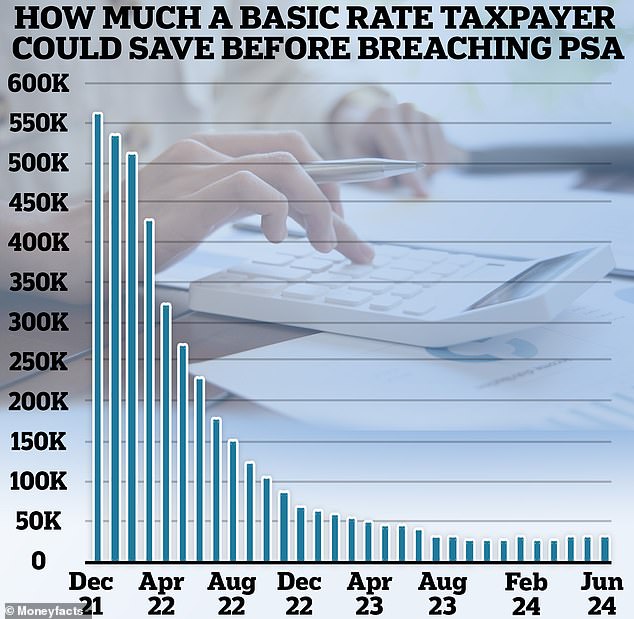Five tips to dodge savings interest tax as a 45p additional rate taxpayer
- HMRC estimates it will receive £10.37bn in savings interest tax this tax year
- £6.8bn of this is expected to come from additional rate taxpayers
- There are now 1.1m additional rate taxpayers, more than double since 2020
Many additional rate taxpayers face tax bills on their savings interest, potentially without realising.
Of this sum, it expects a whopping £6.8billion to arrive from additional rate taxpayers as unlike basic-rate and higher-rate taxpayers, they have no Personal Savings Allowance.
It means 65 per cent of the entire amount HMRC expects to receive for savings interest tax in the current tax year will be paid by additional rate taxpayers.

Claw it back: Additional rate taxpayers are expected to pay £6.8bn in savings interest tax this tax year
There are currently 1.1million additional rate taxpayers in the UK, the latest figures from HMRC for the current tax year show.
This has more than doubled since the 2020/21 tax year when there were 433,000. It means they typically face a bill of £618 each on savings pots.
Additional rate taxpayers have incomes beyond £125,140 and they pay the highest rate of tax at 45 per cent.
Unlike basic and higher rate taxpayers, additional rate taxpayers have no Personal Savings Allowance (PSA), which means all of the interest their savings earn is taxed at 45 per cent.
Because interest rates have risen so much over the last two and a half years and the personal allowance has remained frozen in place, there are going to be more additional rate taxpayers having to pay even more tax in the coming years.
Laith Khalaf, head of investment analysis at AJ Bell said: 'The Office for Budget Responsibility estimates the freeze on the Personal Allowance will create 350,000 more additional rate taxpayers over the next four years.'
Here are five things you can do if you have a large savings pot as an additional rate taxpayer and want to want to claw some of your interest back from the taxman.
1. Max out your cash Isa
The obvious place to start is Isas. Isas are a useful tool for savers to beat tax as they let you save up to £20,000 a year completely tax free.
Every April, savers get a brand new £20,000 annual Isa allowance for the financial year.
That means you can save up to £20,000 in an Isa completely tax free - with any interest made on your savings being free from tax.
Isas are proving more popular than ever due to high interest rates and the Personal Savings Allowance being frozen.
Savers poured £4.2billion into the tax-free accounts in May, new Bank of England data shows.
It comes just a month after savers funnelled a record £12.3billion into Isas in April. The May sum is a record for the month since Isas began in their current form 25 years ago.
Between January 2023 and May 2024, £73.5billion has flooded into cash Isas in the dash to shelter their hard earned savings from the taxman.
Isas now offer attractive rates of 5 per cent or more so there is no reason to shun an Isa for other types of accounts as the rates are as good or better.
An additional rate tax payer putting £20,000 in the best savings account paying 5.02 per cent would earn around £1,004 interest after a year.
An additional rate taxpayer would pay £451.80 in tax on this and so would receive only £552.50 interest, but they would pay no tax on the interest if the £20,000 was in an Isa.
> See This is Money's round up of the five best cash Isas

Even a basic rate taxpayer would now breach their £1,000 PSA with a savings pot of less than £20,000.
2. Max out Premium Bonds
Next up is Premium Bonds. The NS&I accounts are the nation's most popular savings product, with around 22million customers putting their money in the Treasury-backed savings accounts.
Every month, Premium Bonds holders are entered into a prize draw.
Every £1 you invest into Premium Bonds buys you a unique Bond number with an equal chance of winning a monthly prize of between £25 and £1million – there are two £1million prizes per month.
There is no guarantee that you'll win any prize in a given month– but anything you do win is tax free.
Premium Bonds don't earn interest. Instead, there's an annual prize fund rate that funds a monthly prize draw for tax-free prizes.
The current odds of winning a prize are 21,000 to 1, with the annual prize fund interest rate - which is not guaranteed, unlike a savings account or Isa - currently standing at 4.4 per cent.
The maximum amount you can save in Premium Bonds is £50,000.
> Read more: Premium Bonds or a savings account: which would a finance expert choose?
3. Max out your pension contributions
Looking further ahead, pension contributions can be a very efficient way of reducing your income tax bill in general, not only savings interest tax.
The annual allowance is how much you can pay into your pension every year and receive tax relief.
What you can pay in depends on your level of earnings. Everyone has a pension annual allowance of £60,000, or 100 per cent of their relevant earnings if they are less than that.
You can contribute to your pension over and above your annual allowance, but any tax relief applied will need to be repaid through an annual allowance charge.
April Leeson of The Private Office said: 'As an additional rate taxpayer, you might be able to carry forward your unused annual allowance, and therefore tax relief, from up to three years prior, thus paying in more than the £60,000 annual allowance.
'If a saver had £100,000 of savings and was able to pay into their pension, this would mean they would actually receive £25,000 of basic rate tax relief, making a gross contribution of £125,000.'
The money is then within your pension wrapper so cannot be accessed until you are 55, or age 57 from April 2028. While the funds are within your pension, they will grow tax-free.
On anything beyond your 25 per cent tax-free lump sum, the tax payable will depend on your marginal income tax rate at the time plus your rate of withdrawals or income.
By paying money into a pension, you can also claim back higher and additional rate tax relief through your self-assessment each year on your contribution amount, though whether you need to do this depends on the kind of scheme you are in.
If you pay in enough, you can start to claw back your lost 'tapered' personal allowance of £12,570 to allow you to benefit from this tax free amount too.
Depending on how much you earn, your annual allowance may be lower than £60,000, with the full tapered allowance sitting at £10,000.
4. Make the most of other allowances
If you have already maxed out an Isa, Premium Bonds and pension contributions, you could look to use up other allowances to shield more of your savings from savings interest tax if you are an additional rate taxpayer.
If you have investments, one way you could offset your savings tax bill is by using up your dividend allowance.
The dividend allowance is the total amount you can receive in dividends before you must start paying tax on them. It was slashed to £500 for the current tax year from £1,000.
A saver with £100,000 invested into an unwrapped investment would face tax on the dividends, income or interest and capital gains within the investments.
Depending on the type of investments or strategy, there may be more capital growth than dividends or vice versa.
The first £500 of dividends paid each tax year would be free from dividend tax. For additional rate taxpayers, any dividends beyond this £500 would be taxed at 39.95 per cent.
Leeson said: 'If at the end of the tax year the £100,000 was worth £103,000 then there would be no capital gains tax to pay. If it's worth £110,000 after one year, then there could be £10,000 of realised profit.
'Then £3,000 of this is the exempt amount, and the remaining £7000 profit is taxed at 20 per cent. That is £8,600 net profit after tax.
'Compared to if the saver left the funds in cash and somehow made £10,000 interest, then this would be taxed (with no Personal Savings allowance available) at 45 per cent (£4,500) so £5,500 net interest earned (vs. the £8,600 when capital gains applied).'
Savings calculator
Work out how a lump sum or regular monthly savings would grow
- £
- and / or
- £
- years
- %
5. Consider investment bonds
Investment bonds are another way that additional rate taxpayers can offset a savings tax bill.
They aim to grow an investor's money over time. An investor gives a lump sum of money to a life insurance company to invest for you, usually in a range of funds.
There are two categories of investment bond - onshore and offshore. The main difference is their tax treatment.
Onshore bonds are subject to UK corporation tax, which is offset by your provider, while offshore bonds are issued from tax havens outside of the UK, for example the Isle of Man, Dublin, Luxembourg or the Channel Islands, where there is little or no tax charged on the funds.
One of the main advantage of investment bonds is a rule which allows savers and investors to withdraw up to 5 per cent of their investment into a bond, each policy year, without incurring an immediate tax bill until 100 per cent of the policy has been withdrawn.
Savers do not pay tax on their bond gains until a chargeable event occurs. A chargeable event can include death where benefits are payable or the policy reaching maturity.
This tax 'deferral' is one of the features that sets investment bonds apart from other type of investments.
Leeson said: 'Both onshore and offshore investment bonds offer different tax treatment but can result in a big income tax saving, most usually when the additional rate taxpayers stop earning so much (and therefore become basic rate taxpayers).'
SAVE MONEY, MAKE MONEY
Affiliate links: If you take out a product This is Money may earn a commission. These deals are chosen by our editorial team, as we think they are worth highlighting. This does not affect our editorial independence.

























































